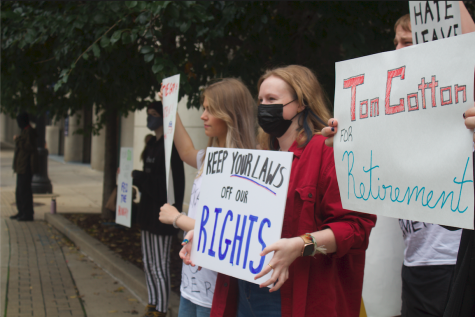Flint water crisis: where are we now?
One year ago, on Oct. 2, 2015, Gov. Rick Snyder publicly acknowledged that high levels of lead had been reported in Flint residents’ water. Today, after a seven-month-long federal state of emergency and millions of dollars in aid, many of Flint’s residents still rely on bottled water to meet their day-to-day needs, and the long-term effects of the crisis are just beginning to emerge.
Although the state has provided $25 million toward the cost of replacing lead pipes in Flint, the process has been slow-going. On Oct. 17, crews finished phase two of Flint Mayor Karen Weaver’s three-phase initiative to replace lead pipes in Flint homes, bringing the total number of homes served by the initiative up to 251 — still far short of the thousands that need pipes replaced.
The third phase of Weaver’s program is expected to begin next week. Project coordinator Michael McDaniel hopes the third phase will be able to replace the lead-contaminated service lines of 5,000 affected homes.
Meanwhile, the EPA’s website still urges Flint residents not to drink, cook, brush teeth or bathe children in unfiltered water. Even residents of homes that returned test results with no detectable lead are still being urged to filter their water or use bottled water. The EPA recommendation, in an FAQ section, reads: “Your low lead test result is encouraging, but the results are from a specific sample showing a snapshot in time. So it doesn’t mean that your water is always safe to drink … Everyone, including pets, should drink filtered or bottled water until further notice.”
And it’s not just the water the city has to worry about. The cost of the onslaught of litigation surrounding the water crisis has left the city of Flint in financial ruins.
In letters to the state treasury department, Flint officials claim the city’s legal bills could reach $32.9 million.
“It is explicitly evident that litigation as a result of either the water crisis, or decisions made by a state-appointed emergency manager, have placed the city’s fragile financial state in jeopardy,” chief legal officer Stacy Erwin Oakes said in a Sept. 20 letter to the state treasurer Nick Khouri.
“Even more alarming is the fact that the City is now a defendant in two class-action suits and over 20 other lawsuits involving water quality (lead) issues. The strain on the city’s cash flow and staff could become catastrophic very quickly.”
The city of Flint is asking the state of Michigan to help pay for these and other costs, including the $5 million the city will owe to the Detroit water system for its water bills since it switched away from the corrosive Flint River water source.
More lawsuits and investigations surrounding the water crisis continue to pile up.
On Oct. 18, the Detroit Free Press reported that the ACLU has filed a lawsuit against Flint school districts for supplying schoolchildren with lead-contaminated water. The lawsuit charges the school with violating the Individuals with Disabilities Education Act for the school districts’ failure to test students for disabilities and refer them to proper treatment.
According to the lawsuit, Flint schools are punishing children with expulsion and suspension rather than testing and treating them for disabilities.
One Flint parent, Nakiya Wakes, describes how her son was suspended 50 times last year; the school ignored her plea to evaluate him for disabilities, despite Wakes’ explanation that her son had tested for high levels of lead. High levels of lead in the blood of children is known to lead to developmental and learning disabilities and behavioral problems, among other potential health issues.
Another of the most recent legal attacks was Flint resident Keri Webber’s request that a circuit court investigate Snyder’s approval of two million dollars to pay for lawyers for himself and the state government.
Webber alleged that Snyder’s use of taxpayer money to fund his legal expenses violated the state constitution and constituted a conflict of interest for Snyder. The case was dismissed by the court last week, and Snyder’s office issued a statement saying that Snyder’s approval of the expenses was legal, since it pertained to his official role as governor.
An internal investigation by the EPA last week concluded that the EPA could have intervened in Flint seven months before they did. On Oct. 20, the inspector general for the EPA, Arthur Elkins Jr., issued a report saying the EPA had “enough information and authority to issue an emergency order under the Safe Drinking Water Act as early as June 2015.”
Elkins criticized the agency for waiting to act even though the EPA’s evidence indicated that there were high levels of lead having adverse effects in the city. The EPA’s regional administrator for Michigan resigned earlier this year.
Attorney general Bill Schuette heads up the state investigation into criminal wrongdoing surrounding the Flint water crisis. So far, Schuette has accused nine current and former government employees with charges related to the Flint crisis.
While these public accusations and revelations build, Flint residents continue to face the fact that, a year after the public health department officially told residents to stop drinking the water, their water remains undrinkable.
One of the effects of the residents’ continued mistrust of the water system has been the outbreak of disease in the county. In early October, reports revealed that Genessee County has the highest rates — by far — of Shigellosis, a contagious bacterial disease. Genessee, which includes Flint, reported 84 cases. The next highest county reported 47.
Health officials suspect that the water contamination is to blame — not for spreading the disease, but because residents are skipping baths and showers, resulting in a decrease in general hygiene, and are resorting to using baby wipes to clean their hands, which don’t kill bacteria as effectively.
Nayyirah Shariff, an activist and community organizer, says another continuing problem is lack of communication from government officials. In an interview with Michigan Daily, Shariff said, “We’re doing triage because of gaps in information. The prevailing message is it is safe to use filtered water but what they don’t tell you is you have to change your filter at least once a month and that these filters do not take out any biological contaminants. You have people being diagnosed with E. coli and dysentery. People aren’t properly educated on these filters.”
Shariff also noted that aid has slowed significantly as Flint has left the national spotlight, despite the still-urgent need for bottled water. Though able-bodied people can carry crates of water from donation centers to their homes every week, the disabled and the elderly cannot, and there is no system in place ensuring they are served.
Though residents continue to struggle with day-to-day water needs, a few recent grants suggest the country continues to be invested in helping Flint recover.
In early October, the national Department of Education granted Flint Community Schools an award of $480,000 through the School Emergency Response to Violence, known as Project SERV. The grant will provide for twelve additional professionals to serve in Flint schools. The hirees will include attendance specialists, counselors, psychologists and special education specialists.
In addition, the Substance Abuse and Mental Health Services Administration announced a five-year grant of more than $970,000 to the city on Oct. 15. The federal grant, called Resiliency in Communities After Stress and Trauma, will help residents to gain access to health services, with a particular focus on families and children.







